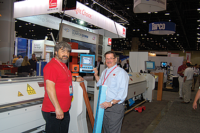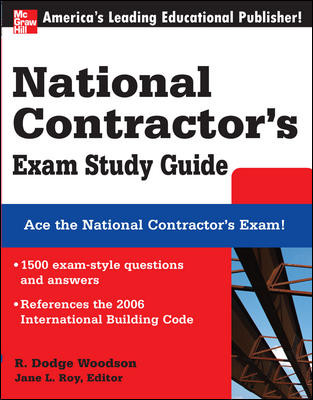
A tough economy often means that R & D dollars are harder to wring out of the budget. However, there are still innovations to be found at the roofing industry trade shows, including the International Roofing Expo (IRE), held this February in New Orleans. Roofing Contractor is proud to be the official publication of the IRE. Here are some of the interesting and innovative products, services and initiatives we singled out for our Editor’s Choice mentions this year.

At the IRE, Geoff Stone of MetalForming
demonstrated his computer integrated roof manufacturing system, which includes
a laser measuring system by Leica.
MetalForming's CIRM
It would be difficult, if not impossible, for the editors of Roofing Contractor to recall a time when Geoff Stone of metal machinery provider MetalForming Inc. was not touting one or more new innovations for metal roofing. This season is no different.Stone has been working with engineers at the Georgia Institute of Technology for some time. Their latest innovation is a video interface for MetalForming technicians to see and be seen while diagnosing and servicing the computer-operated machinery that the firm furnishes to roofing and metal contractors nationwide. The firm began offering online diagnosis tools several years ago but taking advantage of emerging bandwidth and video technology, MetalForming is taking the next step to allow technicians the ability to not only look at the software (via the computer) but the hardware (via video) at the same time.
The firm received notice last year for its computer-integrated manufacturing system, which has now been improved and updated. Branded as CIRM (computer integrated roof manufacturing), the latest addition being designed is a laser measuring system by Leica that will ultimately send measurements directly into the CIRM system from the measuring device.
The CIRM system consists of a jobsite metal roof manufacturing system mounted on a flatbed trailer. Oversimplifying here, but it begins with a roll carrier followed by a roll former (with capacity to form multiple panel profiles) and then an inline cutting machine (designed to cut at all angles). The machine takes orders directly from the roof design made in TopView software and forms the needed parts. The last step before production is field measurements to match the plans to the as-built condition. This system is virtually waste-free and the parts all come out custom-made and ready for installation - in order of installation. The new measuring system will make the job faster, easier and will ultimately eliminate the need to manually input dimensions into the CIRM system.
Last, but not least, the latest innovation for the firm’s metal-folding machine is the addition of touch-screen technology. The computerized metal folding machine works from designs made in a variety of ways but always via software that is entered via keyboard or other computer-interface device. The touch-screen enabled system allows the operator to draw out parts on the screen by touch. This method will be preferred by many who prefer to work “visually” as opposed to entering designs by keystroke. It will also be easier in many cases to modify existing drawings by touch. What will they think of next?

CertainTeed’s EnerGen photovoltaic roofing
system was installed on the governor’s residence in Michigan. (Photo courtesy of the Michigan
Governor’s Mansion.)
CertainTeed's EnerGen
There is a world of new solar-power generating systems appearing almost daily. Most are designed to be mounted on the roof of a home or building. The National Roofing Contractors Association (NRCA) and Center for Environmental Innovation in Roofing (CEIR) are working with other industry interests to set standards for solar installations on roofs. One concern is, “Who is going to be the prime contractor on the installation of roof-mounted solar systems?” At the same time, roofing contractors are trying to sort through the avalanche of information coming at them from the many providers of solar systems.Of all the solar systems we have seen or studied, one designed for steep-slope roofing applications caught our attention. This particular system is not remarkable and does not employ any technology that is different from many we have seen. What sets this system apart is that it is offered by CertainTeed Corporation, a manufacturer of steep-slope roofing products. CertainTeed plans to market its EnerGen roof-mounted solar roofing system through its existing network of distribution and roofing contractors.
There are two key reasons this is intriguing. One, roofing contractors will be able to receive not only a solar system but the training they need to sell and install the system. And it is not insignificant that this comes from a source where many roofing contractors are already doing business and have established relationships. More than a little comfort there, especially when launching a system that is so different from most roofing contractors’ basic product offering. CertainTeed’s EnerGen offers homeowners a solar option that will be furnished by a roofing contractor they trust and backed by a company with a long history in the roofing industry.
AccuLynx Business Management Software
Sometimes innovative, time-saving tools are as close as your laptop computer. The AccuLynx system is a 100 percent Web-Based “software as a service” construction management tool designed to help roofers manage their entire business. According to Richard Spanton Jr., CEO of AccuLynx, you can easily organize leads, diagram roofs, create estimates, track the production of jobs, and generate reports on “anything and everything that is important to business operation.”“AccuLynx allows roofers to obtain ‘true accounts receivable’ after the last nail is hammered, not when you create the customer in your books,” said Spanton. “The program also gives you the ability to print purchase orders and crew work orders based off your previously created estimates.”
The system also allows users to create profit forecasts off of estimates prior to signing contracts with a client. “The program will also tell you where your best marketing dollars are spent by tabulating cost of marketing vs. amount of leads and customers created,” said Spanton.

Bilco’s standard Type S and NB roof hatches have
received Miami-Dade County’s Notice of Acceptance, certifying that they conform
to high-velocity hurricane zone standards in Miami-Dade County in Florida.
Featured in the photo is Type S roof hatch.
Bilco's Miami-Dade Approved Hatches
The Bilco Company announced that it now offers roof hatches that have received Miami-Dade County’s Notice of Acceptance (NOA). The NOA certifies that Bilco’s standard Type S and NB steel and aluminum roof hatches conform to high-velocity hurricane zone standards in Miami-Dade County in Florida.When roof hatches were added to the Florida Building Code’s list of hurricane-resistant products in 2007, Bilco began working with Miami-Dade County Building Code Compliance Office to help develop test protocols for hatches. These tests included high-pressure uplift and downdraft cycling, large missile impact and water intrusion.
The company’s Type S and NB hatches feature heavy-gauge construction for overall strength as well as fully welded corners on both the curb and cover and full perimeter gasketing for complete weather-tightness. Hatches are equipped with heavy-duty slam latches to ensure that the covers remain closed under extreme conditions.
Some of Bilco’s enhanced-performance hatches also offer increased insulation for superior thermal performance, an upgrade that improves the energy efficiency of the building. The company states that the energy efficiency of these hatches exceeds that of standard hatches by more than 48 percent. Some models also meet LEED standards for recycled content and offer high solar reflectance.

The SunWave Daylighting Systems skylight from
Firestone features a wavy dome consisting of two layers of acrylic material
that is designed to provide maximum visible light transmittance throughout its
life cycle.
Firestone's SunWave Daylighting Systems
Being rolled out under the Firestone Energy Solutions brand, the SunWave Daylighting Systems skylight employs several unique features. The wave-shaped dome design is said to maximize lighting performance at low sun angles while offering superior strength when compared to standard skylights. The wavy dome consists of two layers of acrylic material that is designed to remain clear and provide maximum visible light transmittance throughout the life cycle of the skylight.The curb-mounted frame is designed to be fully sealed without the use of caulk and is insulated to provide a thermal break. The interior of the frame is clad with exterior-grade vinyl so none of the metal components of the assembly face the interior of the building. This combination results in a fully sealed unit that is highly resistant to condensation.
Available in standard as well as custom sizes, the SunWave Daylighting system from Firestone is also available in a UL and FM Smoke Hatch/Daylight combination.

Saiz Tool Company’s hand-held pneumatic shingle
cutting tool won the “Best New Product” award at this year’s IRE. Inventor
Albert Saiz shows off the tool and the award.
Saiz Tool Company's Shingle Cutting Tool
Saiz Tool Company won the “Best New Product” award at the IRE’s Product Showcase for its pneumatic-powered, hand-held shingle cutting tool. Designed to easily and quickly cut asphalt composition shingles, the cutting tool has replaceable cutting blades and can also be used to cut linoleum flooring, carpet, drywall and other materials. Available soon, this patent-pending product uses the same pneumatic compressor used for a nail gun.“Saiz Tool Company is delighted to receive first place in the Best New Products Awards for its revolutionary shingle cutting tool,” said Albert Saiz, the company’s owner and the inventor of the tool. “We could not be more pleased with this formal recognition, coupled with the excitement we observed from attendees who visited our booth.”

Solderless liquid solution turns the color of
soldered seams from a grey/silver color (as shown on the seam to the left) to
the color of aged copper (as shown on the seam to the right).
Solderless' Liquid Solution
Third place was awarded to Solderless for its liquid solution that turns the color of soldered seams from a grey/silver color to the color of aged copper. Sold in convenient 2-ounce plastic bottles, Solderless was created from the desire to address repeated complaints from homeowners and builders regarding the extreme contrast in colors of new copper roof panels and the soldered seams. The product is a blue liquid that when applied to clean, dry solder, turns the solder to an aged copper color.CEIR's RoofPoint
The Center for Environmental Innovation in Roofing (CEIR) announced its most ambitious initiative to date: RoofPoint. RoofPoint will provide a guideline for the selection of roofing systems that maximize energy efficiency and minimize environmental impact. This makes RoofPoint the most ambitious initiative we have seen in a very long time from any segment of the roofing industry.The CEIR is made up of major roofing contracting, manufacturing, and private capital organizations. The idea for RoofPoint began with the center’s board of directors and is being moved forward by the CEIR Research Committee.
While there is a great deal of interest in green building, there is also a great deal of interest in green “rebuilding.” Retrofitting an existing building to green standards involves the building envelope, including the roof. While green standards for new construction have been institutionalized, they do not work so well in retrofit applications. The void is presently being filled one project at a time without a good guideline. RoofPoint will be built by the best minds in the roofing industry and will provide standards that the design community will find useful and reliable. With RoofPoint, the Center’s focus is certainly not limited to retrofit applications, but we see this as one area where a major void exists and the need for new standards is especially pronounced.
It is not possible to cover everything the center seeks to accomplish with RoofPoint in this very brief feature. RoofPoint is an Editor’s Choice item because we feel it is good for the industry, and it is a good idea for those of you who make your living in this industry to learn about it. Once you do, we think many of you will join with the CEIR and support this important work. You will find more information about the work of the center in future issues of Roofing Contractor. In the meantime, take the time to read about it on their Web site:roofpoint.wikispaces.com/Roofpoint.

With sound remediation in mind, Georgia-Pacific
Gypsum has developed and independently tested a roof system which consists of a
high mass layer of DensDeck roof board and 1-inch minimum porous fiberglass or
fiber insulation board (non-batt). The rock wool or fiber glass insulation
serves as a ventilation layer to alleviate the common problem of moisture
entrapment during roof retrofits.
Georgia-Pacific DensDeck Retrofit Soundproofing
The makers of Georgia-Pacific DensDeck roof board continue to innovate with what is otherwise a now commonplace mixture of gypsum and fiberglass. So how do you make a fairly simple building material more appealing to owners, designers, and contractors? You solve their problems.One problem that the GP DensDeck folks solved came to our attention as we searched for Editor’s Choice items for 2009. The problem was having standards for noise reduction using layers of gypsum cover boards in roofing systems. GP took the initiative and tested various systems to solve specific engineering requirements for use primarily in new construction of airport buildings.
That was all well and good until another problem developed. What about soundproofing for existing buildings? And what about the client does not wish to completely deconstruct his roof or building to meet soundproofing standards? An intriguing project has emerged and the solution is unique.
Seems the FAA decided to change the landing and take-off pattern near one of the nation’s busiest airports sending jetliner traffic right over an existing elementary school. A lot of lawyering later the school has been awarded funding to cure the noise problem and GP has cooked up a solution using its DensDeck in combination with rigid fiberglass insulation. The retrofit system they developed will not only greatly reduce the noise coming through the roof, but will do it without tearing off the existing roof.
Back in the day a great deal of rigid fiberglass, or rockwool insulation was used in recover applications, so there is nothing new there. Just that we have not seen it in this country since forever. The use of this type of insulation adds to the noise reduction and allows for release of the vapor that may be trapped between the existing membrane and the new one. The sound remediation system includes a vented counter-flashing that will allow otherwise trapped vapor to escape.
While the runway versus elementary school application may be a relatively obscure application, we can see where this system may have a broad application near airports where changes in building uses may be desirable. For instance, it may be alright if your warehouse building is in a landing pattern, but what if there was a need for more office or retail space? Whatever may come, at least now owners have a good option and one that is tested.

The
EcoEdge Soil Guard from the W.P. Hickman Company provides a drain-through
separator between different elements of a vegetative roof.
W. P. Hickman's EcoEdge Products
The W. P. Hickman Company has responded to the growing popularity of vegetative roof systems by developing essential metal components engineered to help with drainage and the retention of soil and growth medium. The product line includes the EcoEdge Drain Box and EcoEdge Soil Guard.The EcoEdge Drain Box is available in two standard sizes, and the top cover of the Drain Box is designed for easy removal and access to the drain. Custom sizes are also available. The EcoEdge Soil Guard provides a drain-through separator between different elements of a vegetative roof. Whether the roof system design includes ballast, pavers, tray systems, or soil and growth medium, EcoEdge Soil Guard is a strong divider between materials.
EcoEdge Soil Guard can also be ordered in custom sizes, metals, colors, or finishes to meet the needs of the project. The Soil Guard is also available pre-punched or without slots depending on the design of the water flow or the materials that it is separating.

Ken Collister accepted the IRE’s second place
award on behalf of Smartman Tools for the RacJack.
Smartman Tools' RacJack
Capturing second place in the IRE’s New Product competition was Smartman Tools’ RacJack product, a roof jack system that makes starting steep roofs easy without ladder jacks or scaffolding. The RacJack, with its optional safety rail, creates a walkway above the gutter that doesn’t have to be removed for the entire job, allowing roofing contractors to apply drip edge, ice shield and starter rows from the roof.
GAF's Cobra FasciaFlow Intake Vent
Over the years roofing contractors have had few choices when it comes to improving intake ventilation systems. They could remove and replace existing soffit systems (expensive and time consuming) or install one of several eaves ventilation systems on the market. Eaves ventilation systems do provide a good solution and may be installed between the tear-off and installation of the new roof.GAF Materials Corporation has introduced a product that provides a solution that will add needed intake ventilation while putting a very nice finishing touch to a new roof. The FasciaFlow™ Premium Intake Vent consists of a composite fascia board with built-in ventilation. This patented design provides 9 square inches of net ventilation area per lineal foot.
With many retrofit roofing installations some soffit must be replaced, which is a slow process. With the replacement of the entire soffit system the installer will not lose any time cutting and installing individual sections of soffit. The installation is completed without having to cut the roof deck as with some other intake ventilation solutions.
Roofing contractors know the many problems associated with poor attic ventilation, including premature roof deterioration, moisture buildup in the attic, and even ice damming in some applications. In addition to an improved roof ventilation system, the homeowner will appreciate the enhanced appearance of the finished roof when it includes the new fascia.





Report Abusive Comment